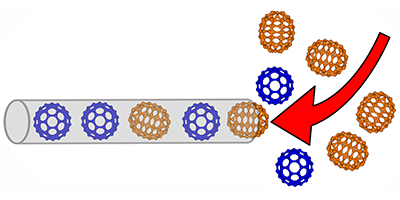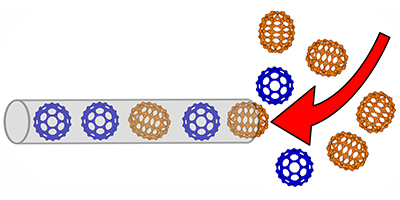Electrons Reveal Molecular Geometries
The development of atomic-scale devices for nanoelectronics relies on the ability to identify individual atoms and molecules as well as their geometry and electronic structure. Electron energy-loss spectroscopy (EELS) is a powerful technique to map the atomic makeup of a sample but not for determining its molecular structure, for instance, discriminating between allotropes—different geometrical arrangements of atoms of the same element. By enhancing the resolution of EELS, Luiz Tizei and colleagues from the National Institute of Advanced Industrial Science and Technology, Japan, have been able to identify two individual allotropes ( and fullerenes) trapped inside carbon nanotubes.
In EELS, a beam of electrons with a well-defined energy is scanned over a material. When the beam interacts with the sample, transferring energy to the sample’s molecules, some electrons loose their energy. This loss peaks at certain energies, which are related to the mechanisms that caused it, such as the resonant interaction with an electronic transition. EELS can easily identify different chemical elements, but revealing other details (chemical bonding or the presence of different allotropes) would require measurements of the energy-loss spectrum with thus-far unattainable resolution.
By optimizing the signal-to-noise ratio and minimizing molecular damage from the electron beam, Tizei and his colleagues were able to increase the resolution of the energy-loss spectrum measured. Now, instead of a broad fuzzy peak at kilo-electron-volts (characteristic for carbon), their sample showed multiple well-defined peaks, revealing the fine structure of the energy-loss process and yielding spectra that could be assigned to and . The authors suggest their technique could identify other carbon allotropes ( and ) and carbon atoms with different chemical bonds (e.g., C=O, C–H).
This research is published in Physical Review Letters.
–Katherine Wright





